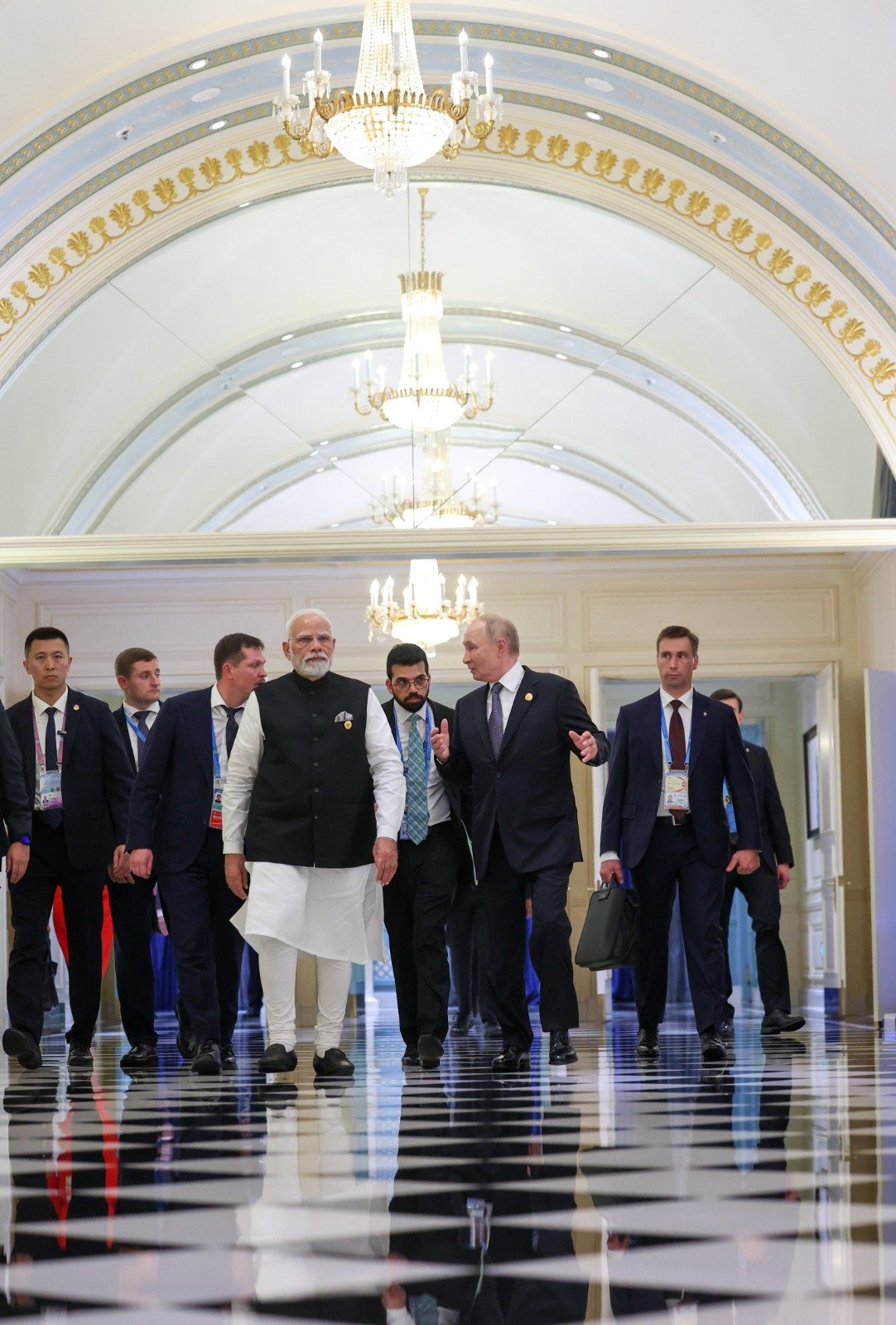India, Russia, and China Signal New Multipolar Axis at SCO Tianjin; End of American Dominance
Indian Prime Minister Narendra Modi’s bilateral meeting with Russian President Vladimir Putin on the sidelines of the Shanghai Cooperation Organisation (SCO) Summit in Tianjin has reinforced what many analysts are calling the most significant diplomatic recalibration of the decade: the visible consolidation of India, Russia, and China as a counterweight to U.S. economic coercion and global dominance.
 |
| Image Source: PMOIndia |
The meeting came a day after Modi’s discussions with Chinese President Xi Jinping, where both leaders welcomed “positive momentum” in bilateral ties, reaffirmed border stability, and committed to cooperation based on “mutual trust, respect, and sensitivity.”
Together, the optics of Modi–Xi and Modi–Putin back-to-back meetings signalled India’s active role in shaping what Russian diplomats describe as a “qualitatively new system of international relations.”
Putin–Modi Bilateral: Special and Privileged Partnership Holds
At their Tianjin meeting, Modi and Putin expressed satisfaction over sustained cooperation in energy, finance, and trade, including fertilisers, defence, and civil nuclear. They discussed correcting the $58.9 billion trade imbalance and expanding use of national currencies in settlements -- an explicit hedge against U.S.-controlled financial systems.
Modi supported recent peace initiatives on Ukraine, stressing the need for “an expedited ceasefire and durable settlement,” while Putin briefed him on his Alaska talks with U.S. President Donald Trump. The two leaders agreed to accelerate preparations for the 23rd India–Russia Annual Summit in New Delhi later this year, where Putin is expected to sign a major package of agreements.
In a post on X, Modi described the talks as “excellent,” adding that the India–Russia “Special and Privileged Strategic Partnership remains a vital pillar of regional and global stability.”
Xi–Modi Meeting: Dragon and Elephant as Partners
The day prior, Xi Jinping told Modi it was vital for the “dragon and the elephant to come together,” stressing that as the world’s two most populous and civilizational states, China and India must act as “friends and good neighbours.” Xi made four suggestions -- deepening mutual trust, expanding exchanges, addressing each other’s concerns, and strengthening multilateral cooperation -- all of which Modi responded to positively.
Modi noted the “peace and tranquillity” along the border since disengagement and welcomed the resumption of direct flights and the Kailash Mansarovar Yatra. Both leaders affirmed that India and China were “partners, not rivals,” and that differences should not become disputes.
Foreign Secretary Vikram Misri later emphasised that both sides agreed their relations “should not be seen through the lens of any third country” -- a pointed message as U.S. tariffs reshape trade alignments.
U.S. Tariffs as the Catalyst
The deepening of India’s engagements with both Moscow and Beijing comes against the backdrop of U.S. President Trump’s tariff blitz.
In August, Washington doubled duties on Indian exports to 50%, citing New Delhi’s continued imports of discounted Russian oil. India, which sources 44% of its crude from Russia, has rejected the move as “unjustified and unreasonable.”
External Affairs Minister S. Jaishankar defended India’s position in Moscow, pointing out that China is the largest purchaser of Russian oil and the European Union is the largest LNG buyer.
“We are perplexed at the inconsistency in the argument,” he said, calling U.S. economic coercion both selective and hypocritical.
Russia has echoed this stance, with Foreign Minister Sergey Lavrov labelling the tariffs “yet another attempt to weaponise trade.”
Moscow has pushed for alternative settlement systems, regional transport corridors like the International North-South Transport Corridor, and enhanced BRICS mechanisms to dilute dollar dependence.
Multipolarity Becomes Visible
The SCO stage in Tianjin -- featuring Modi, Putin, and Xi shoulder to shoulder -- crystallised what has long been theorised: a multipolar Asia anchoring a multipolar world.
Putin, addressing the plenary, underscored that UN principles of sovereignty remain “valid and unshakable,” while Xi denounced “bullying behaviour” in the global order and called for resisting “Cold War mentality.”
Modi meanwhile used his address to stress that the SCO is built on “Security, Connectivity, and Opportunity,” linking India’s domestic principle of “Reform, Perform, Transform” with its global outlook.
Together, the three leaders projected a coordinated narrative: peace must be built on sovereignty, coercion must be resisted, and Asia must chart its own course.
Global South and Beyond
India’s role at the summit also extended beyond its Russia and China engagements. Modi held meetings with leaders from Kazakhstan, Kyrgyzstan, Uzbekistan, Vietnam, Armenia, Egypt, and others, describing the interactions as productive and forward-looking.
These meetings underscored New Delhi’s broader Global South positioning -- building coalitions that resist unilateral sanctions, diversify trade, and promote sovereignty in economic choices.
Russia’s envoy to international organisations, Mikhail Ulyanov, captured the sentiment succinctly: the growing India–Russia–China partnership, he said, represents a “qualitatively new system of international relations.”
What Comes Next
With Putin set to visit India later this year, Xi invited to the 2026 BRICS Summit in New Delhi, and U.S. tariffs continuing to bite, India is visibly pursuing a balancing strategy:
-
Russia for energy and defence stability
-
China for regional coexistence and economic alignment
-
Japan for technological and investment depth
-
The U.S. for long-term strategic, but now strained, convergence
The Tianjin SCO summit has therefore became the venue where multipolarity ceased to be aspirational rhetoric and emerged as visible reality, with India at the centre of this shifting world order.
